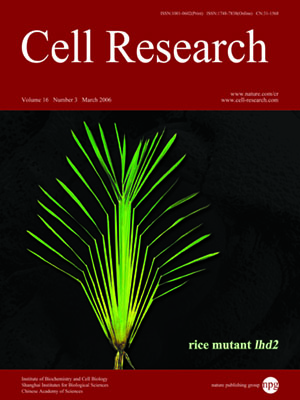
Volume 16, No 3, Mar 2006
ISSN: 1001-0602
EISSN: 1748-7838 2018
impact factor 17.848*
(Clarivate Analytics, 2019)
Volume 16 Issue 3, March 2006: 267-276
ORIGINAL ARTICLES
LEAFY HEAD2, which encodes a putative RNA-binding protein,regulates shoot development of rice
Guo Sheng Xiong1, 3, *, Xing Ming Hu2, *, Yong Qing Jiao1, Yan Chun Yu1, Cheng Cai Chu1, Jia Yang Li1,
1State Key Laboratory of Plant Genomics and National Center for Plant Gene Research, Institute of Genetics and Developmental
Biology, Chinese Academy of Sciences, Beijing 100101, China; 2 State Key Laboratory of Rice Biology, China National Rice Research
Institute, Chinese Academy of Agricultural Sciences, Hangzhou 310006, China; 3Graduate University of Chinese Academy
of Sciences, Beijing 100049, China
Correspondence: Yong Hong Wang, Qian Qian(yhwang@genetics.ac.cn qianqian188@hotmail.com )
During vegetative development, higher plants continuously form new leaves in regular spatial and temporal patterns. Mutants with abnormal leaf developmental patterns not only provide a great insight into understanding the regulatory mechanism of plant architecture, but also enrich the ways to its modification by which crop yield could be improved. Here, we reported the characterization of the rice leafy-head2 (lhd2) mutant that exhibits shortened plastochron, dwarfism, reduced tiller number, and failure of phase transition from vegetative to reproductive growth. Anatomical and histological study revealed that the rapid emergence of leaves in lhd2 was resulted from the rapid initiation of leaf primordia whereas the reduced tiller number was a consequence of the suppression of the tiller bud outgrowth. The molecular and genetic analysis showed that LHD2 encodes a putative RNA binding protein with 67% similarity to maize TE1. Comparison of genome-scale expression profiles between wild-type and lhd2 plants suggested that LHD2 may regulate rice shoot development through KNOX and hormone-related genes. The similar phenotypes caused by LHD2 mutation and the conserved expression pattern of LHD2 indicated a conserved mechanism in controlling the temporal leaf initiation in grass.
Cell Research (2006) 16:267-276. doi:10.1038/sj.cr.7310034; published online 16 March 2006
FULL TEXT | PDF
Browse 1861


